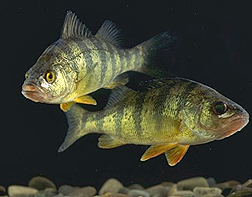This page has been archived and is being provided for reference purposes only. The page is no longer being updated, and therefore, links on the page may be invalid.
|
|
|
|
ARS, Cooperators Find Genes Involved in Yellow Perch Growth
By Chris Guy
June 11, 2010
Twenty-eight genes that are involved in bulking up yellow perch—an important aquaculture fish in the Great Lakes region—have been discovered by Agricultural Research Service (ARS) scientists and university researchers.
Usually, female perch grow faster than their male counterparts, a disparity that causes productivity losses because farmers have to sort out the smaller males. Also, the smaller males still need to be maintained on feed until they reach market size, delaying harvest and increasing production costs.
Improvements in production efficiency of the U.S. perch industry would strengthen the farmers’ regional and global competitiveness.
Animal physiologist Brian Shepherd, at the Milwaukee, Wis.-based aquaculture research unit affiliated with the ARS U.S. Dairy Forage Research Center in Madison, Wis., worked with scientists from the University of Wisconsin’s WATER Institute in Milwaukee. The Great Lakes WATER (Wisconsin Aquatic Technology and Environmental Research) Institute is the largest academic freshwater research facility in the region.
In their indoor tank study, the researchers discovered the growth-linked genes by feeding perch standard diets supplemented with estrogen. Estrogen is not fed to fish in commercial production. The researchers only used it to trigger genes that control growth.
After three months, the perch were much larger. Researchers then sequenced genes from the fish livers to better understand the actual molecular mechanisms by which estrogen promotes growth in males versus females. They found 28 genes that may be involved in the link between estrogen and growth. Understanding the involvement of these genes in growth, and possibly in other commercially important traits, should help breeders boost yellow perch production efficiency.
This research was published in Physiological Genomics.
ARS is the principal intramural scientific research agency of the U.S. Department of Agriculture (USDA). The research supports the USDA priority of promoting international food security.

